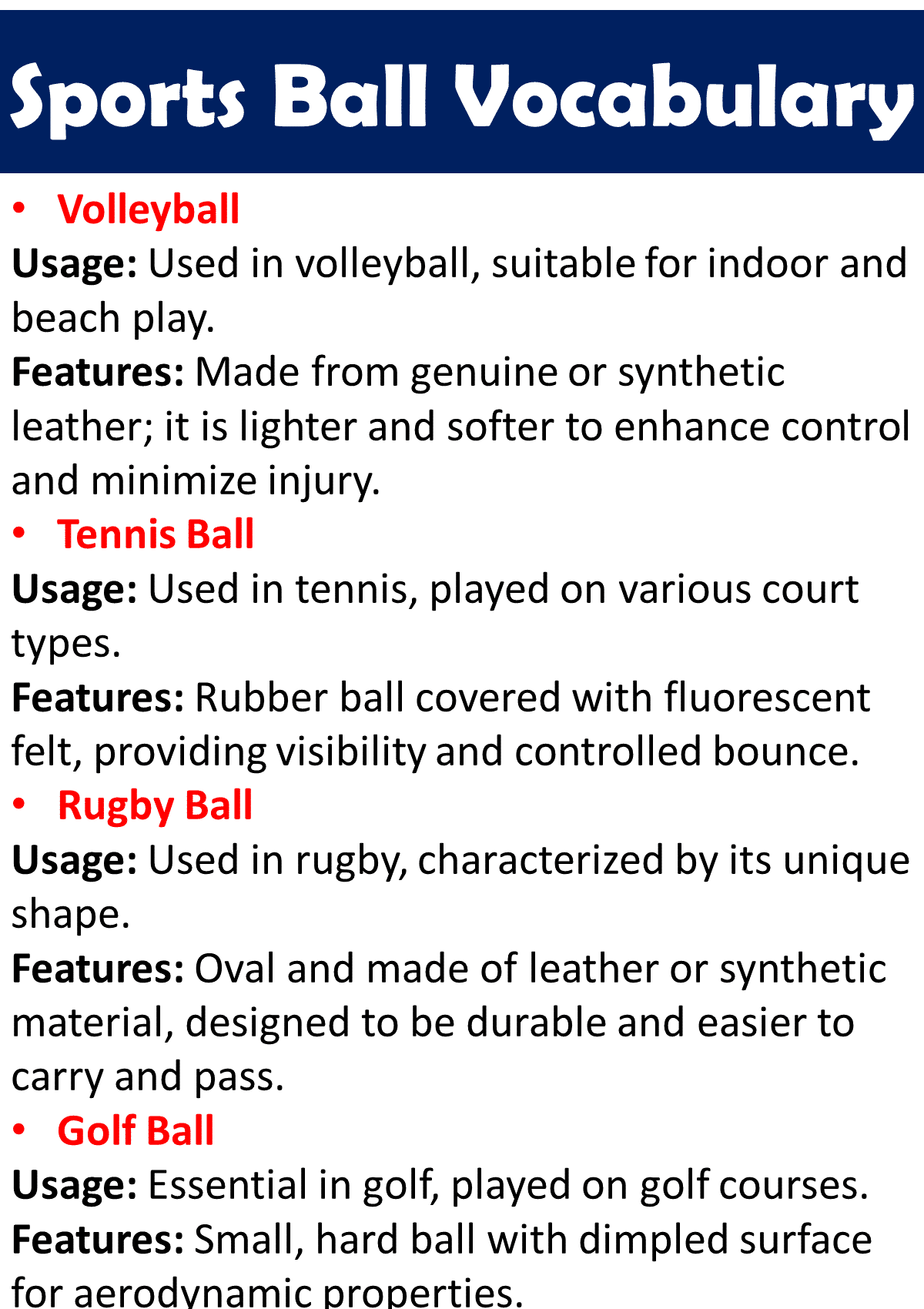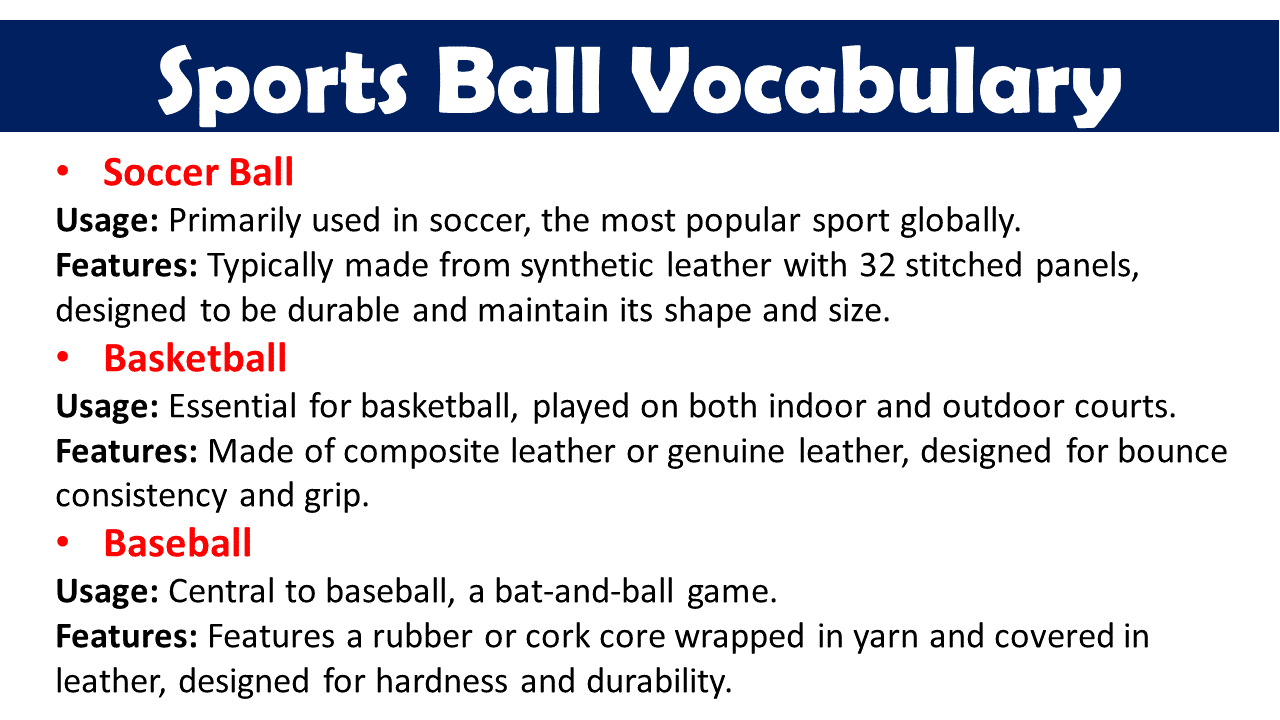Sports ball vocabulary is essential for anyone interested in understanding or participating in various sports. Each sport features a distinct type of ball, specifically designed to meet the demands of that game. For instance, the soccer ball is round and built for kicking, while the basketball is larger and designed for dribbling and shooting. In tennis, the ball is small, lightweight, and covered in felt to optimize performance on the court.
Similarly, sports like baseball, rugby, and volleyball have their own uniquely designed balls, each tailored to enhance the gameplay. Familiarity with these terms not only enriches your understanding of the sport but also enhances your ability to communicate effectively, whether you’re playing, watching, or discussing the game. Learning the specific vocabulary associated with sports balls is a key step in gaining a deeper appreciation and knowledge of various athletic activities.
Sports Ball Vocabulary
Understanding the various types of sports balls is crucial for any sports enthusiast. Each type of ball is designed specifically for its respective sport, considering factors like size, material, and intended use. Here’s a comprehensive look at different sports balls, highlighting their unique characteristics.
Soccer Ball
- Usage: Primarily used in soccer, the most popular sport globally.
- Features: Typically made from synthetic leather with 32 stitched panels, designed to be durable and maintain its shape and size.
Basketball
- Usage: Essential for basketball, played on both indoor and outdoor courts.
- Features: Made of composite leather or genuine leather, designed for bounce consistency and grip.
Baseball
- Usage: Central to baseball, a bat-and-ball game.
- Features: Features a rubber or cork core wrapped in yarn and covered in leather, designed for hardness and durability.
Volleyball
- Usage: Used in volleyball, suitable for indoor and beach play.
- Features: Made from genuine or synthetic leather; it is lighter and softer to enhance control and minimize injury.
Tennis Ball
- Usage: Used in tennis, played on various court types.
- Features: Rubber ball covered with fluorescent felt, providing visibility and controlled bounce.
Rugby Ball
- Usage: Used in rugby, characterized by its unique shape.
- Features: Oval and made of leather or synthetic material, designed to be durable and easier to carry and pass.
Golf Ball
- Usage: Essential in golf, played on golf courses.
- Features: Small, hard ball with dimpled surface for aerodynamic properties.
Cricket Ball
- Usage: Used in cricket, similar to baseball.
- Features: Made of cork core and covered with stitched leather, extremely hard.
Hockey Puck (Not a ball, but a key object in hockey)
- Usage: Used in ice hockey.
- Features: Made of vulcanized rubber, flat and circular, designed to slide on ice smoothly.
Ping Pong Ball
- Usage: Used in table tennis.
- Features: Very light, made of celluloid or similar plastic, designed for high bounce and fast speed.
American Football
- Usage: Used in American football.
- Features: Made of leather or synthetic, it’s pointed at both ends to aid in passing and catching.
Bowling Ball
- Usage: Used in bowling.
- Features: Made of hard rubber or a polyurethane derivative, with finger holes designed for gripping.
Lacrosse Ball
- Usage: Used in lacrosse.
- Features: Made of solid rubber, it’s small and dense to withstand high impact.
Billiards Ball
- Usage: Used in billiards or pool games.
- Features: Hard, typically made of phenolic resin to resist wear and impact.
Explore More Words:

Bocce Ball
- Usage: Used in bocce, an ancient game.
- Features: Made of metal or plastic, heavy and targeted for precision rolling.
Squash Ball
- Usage: Used in squash, played indoors.
- Features: Small, rubber ball that softens and speeds up with play.
Handball
- Usage: Used in team handball.
- Features: Made of rubber or synthetic, small and designed for throwing and catching with hands.
Water Polo Ball
- Usage: Used in water polo.
- Features: Has a rough texture to ensure grip in water, made of waterproof material.
Futsal Ball
- Usage: Used in futsal, a variant of soccer played indoors.
- Features: Smaller, less bouncy than soccer balls to suit indoor play.
Netball
- Usage: Used in netball.
- Features: Similar to a basketball but with a slightly different texture and size for grip.
Paddle Ball
- Usage: Used in paddle sports.
- Features: Rubber ball connected to a paddle with a string, used for leisure activities.
Polo Ball
- Usage: Used in polo, played on horseback.
- Features: Made of wood or plastic, designed for hitting long distances.
Racketball
- Usage: Used in racquetball.
- Features: Similar to a squash ball but larger and more bouncy.
Softball
- Usage: Used in softball, similar to baseball.
- Features: Larger than a baseball and often softer, designed for pitching underhand.
Dodgeball
- Usage: Used in the game of dodgeball.
- Features: Made of foam or rubber, designed to be soft and easy to throw.
Beach Ball
- Usage: Used for beach games.
- Features: Large, inflatable, and lightweight, designed for water and beach play.
Field Hockey Ball
- Usage: Used in field hockey.
- Features: Hard, made of plastic or cork, designed to be played on grass and artificial surfaces.
Jai Alai Ball (Pelota)
- Usage: Used in jai alai, a fast-paced game.
- Features: Very hard, made of rubber covered with goatskin.
Gaelic Football
- Usage: Used in Gaelic football.
- Features: Similar to a soccer ball but heavier.
Australian Rules Football
- Usage: Used in Australian rules football.
- Features: Larger than an American football and made of leather.
Sliotar
- Usage: Used in hurling.
- Features: Similar to a baseball but with raised seams for better grip during play.
Badminton Shuttlecock
- Usage: Used in badminton (not a ball, but essential).
- Features: Feathered projectile, designed for aerodynamic stability.
Sepak Takraw Ball
- Usage: Used in sepak takraw.
- Features: Made from rattan or synthetic fiber, extremely light and flexible.
Medicine Ball
- Usage: Used for exercise and training.
- Features: Heavy and durable, designed to enhance strength training.
Korfball Ball
- Usage: Used in korfball, similar to netball and basketball.
- Features: Similar in size to a basketball but lighter.
Speed Ball
- Usage: Used in speedball, a mixture of different sports elements.
- Features: Lightweight and designed for fast play.
Roller Hockey Ball
- Usage: Used in roller hockey.
- Features: Hard plastic, designed to roll smoothly on different surfaces.
Street Hockey Ball
- Usage: Used in street hockey.
- Features: Lighter and softer than ice hockey pucks, designed for safer play on streets.
Cue Ball
- Usage: Used in cue sports like snooker and pool.
- Features: Solid, typically white, used to strike other balls.
Kabaddi Ball
- Usage: Used in training for kabaddi (the sport traditionally does not use balls).
- Features: Soft and easy to grip, used for practice throws.
Carpet Ball
- Usage: Used in carpet bowling.
- Features: Hard and heavy, designed to roll on indoor carpets.
Molkky Skittles Ball
- Usage: Used in Molkky, a Finnish throwing game.
- Features: Wooden, used to knock over pins.
Pickleball
- Usage: Used in pickleball.
- Features: Similar to a wiffle ball, lightweight and with holes for airflow.
